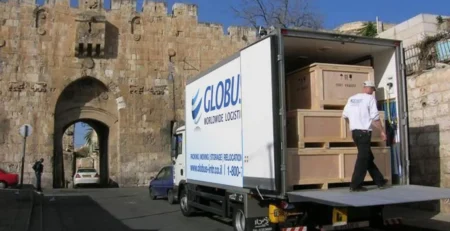ICEFAT COVID AFTERMATH: Part 1
- Company News

The world of fine art logistics was brought to an almost complete halt by the onset of coronavirus in the first half of 2020. Efforts to curb the virus are ongoing and showing signs of success, meaning many countries are starting to cautiously proceed out of lockdown measures. Cultural sectors are reigniting, but for that to happen successfully, a strong logistical support system – fine art shipping – is needed. As “the unseen engine room of the art world” rolls back into action, we’ve spoken to our membership to discover how their businesses operated during lockdown, how they’re proceeding out of their pause in operations, and what the new normal looks like for their operations. In a three-part report, we’re sharing their insights.
The Restricted Flow and Increased Cost of Air Freight
One major factor in the complete or partial shutdowns imposed by national governments was the limitation of air transport to keep in check the spread of the virus. Remaining air freight capacity was rightly prioritised to essential goods and medical supplies needed to support efforts against the disease. Although air freight accounts for just 4% of international freight movement, it makes up about half of the total value transported globally. Therefore, as a main way that art is shipped between museums, galleries, and private collections around the world, the decrease in air freight meant less business for fine art shippers. As Jonathan Schwartz, CEO of US-based Atelier 4 and Chairman of ICEFAT, summarises: “the limited capacity both restricted flow and increased cost,” meaning that fine art shippers were unable to carry out their services without substantial barriers.
In India, the government began a complete lockdown of international and domestic flights on March 23, and, like Schwartz’s summary of the US situation, only all-cargo flights were allowed to operate. “This significantly reduced belly space for air freight, which resulted in a huge hike in air freight rates, sometimes as much as three times pre-Covid-19 rates”, reports Al Mithal, CEO of Star Worldwide, an ICEFAT member based in New Delhi. Another Indian ICEFAT member, Mithals International, reports the same threefold increase in rates. Anil Mithal, CEO of the company, also notes that “there is very little commercial cargo and certainly no fine art shipments, so it has affected our services substantially.”
Although Japan’s government did not impose a countrywide lockdown, much of the country paused normal operations to see out the virus. Shige Moriyama, Art & Exhibitions Manager of Tokyo-based member Yamato Global Logistics, reports that international cargo flights remained fully operational at this time, but passenger flights decreased by 90%. Moriyama expects “we might need to wait several years” before normal air freight service is resumed. Like India, air freight rates in Japan spiked, meaning that companies such as another Tokyo-based member Katolec, had to postpone shipments as its clients were hesitant to ship due to the increase in air freight rates.
The case was similar in Europe, which led to an inevitable decrease in business. Sara Volani of Swiss-based Züst & Bachmeier notes that the much higher air freight rates caused “quotes to clients to be mostly rejected or shipments postponed [until rates decrease again]. In the first week of July, rates began to decrease. Therefore, we’re seeing an increase in requests again.” UK-based Gander & White Shipping has experienced the same high freight rates, with Business Development Director Alexander Bradford pointing out that “many clients are opting to hold off on shipments until rates come down”. Klaus Hillmann, Director at Tandem based in Frechen, Germany, had a slightly more positive experience, reporting that “the volume was significantly lower, but the reduced volume could be transported.”
Now hopefully past the initial spike of the pandemic and the necessary measures to impede its spread, there are signs that air freight is recovering its capacity, and rates are beginning to slowly decrease. Kerry Thompson, an Associate Director of Canada-based PACART, is seeing “an optimistic but cautious return [of air freight traffic] to some level, but nowhere near the pre-Covid levels”. It seems clear that recovery will take a while yet.

Sea Freight Not The Solution
Could there be an alternative while air freight stutters? Although sea freight has been regarded as more environmentally sustainable, emitting far less CO2 per tonne transported than air freight, it is not currently deemed a viable replacement for shipping the high value art that forms the majority of ICEFAT agents’ shipments. Jonathan Schwartz of Atelier 4 points out that other sustainability testing measures do not show there to be a big gap between the two types of freight transport. Schwartz says that “ocean freight has additional pollutants such as transfering ballast containing plant, animal, bacteriological and viral elements from one region of the world to another; noise pollution affecting sea mammal navigation; collision with sea life, solid and wastewater emissions; and, oil leaks via bilge, to name a few.”
Moreover, the logistical practicalities of shipping delicate and high-value art means sea freight is rarely an option. Klaus Hillmann of Tandem notes that “in addition to the long transit time, the required booking volumes and infrequent departures are not favorable in an industry characterized by high values, sensitive goods and narrow time windows.” The fast turnaround times enabled by air freight, and impossible with seafreight, are highly valued by clients; Sara Volani of Züst & Bachmeier points out that “sustainability is very important, but we cannot give up on required urgent timings that usually are requested.” Anil Mithal of Mithals International also points out that “fine art shipments mostly consist of one or two crates. These will continue to travel as air freight,” the reason being that clients will not want to buy more space than they need, as would be the case in a shipping container.
“Museums, in particular, are always extremely wary of using sea freight, unless it is for very large and sturdy works, such as sculptures,” says Al Mithal of India’s Star Worldwide. Yamato’s Shige Moriyama agrees, adding: “particularly for expensive works, it would still be difficult for a lender to allow an organizer to send by ocean.” Japanese ICEFAT member Katolec says that maritime companies “always request the value of the artwork, and sometimes they refuse the shipment when the artwork is too expensive for them.” It is clear that shipping by sea may be cheaper, but it is not preferred by fine art shippers or by their clients.
Instead of sea freight, many ICEFAT members are looking at how to increase consolidation of freight on existing routes, such as reducing transport to and from airports by grouping transports. Until technology develops to the point that air freight is made more sustainable, fine art shippers are making efforts to ensure that their current systems are as sustainable as possible.
While sustainability is a vital goal for all businesses to have, the global economic downturn caused by coronavirus has caused companies to prioritise other immediate business challenges. Greg Gahagan of US West Coast-based Ship/Art notes that “Covid-19 reduces the time, energy, and financial resources that might normally go toward the thought process and the time to do business in a more sustainable way.”










